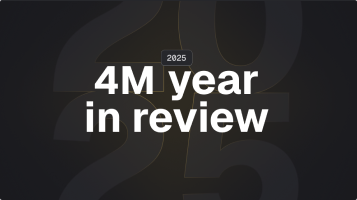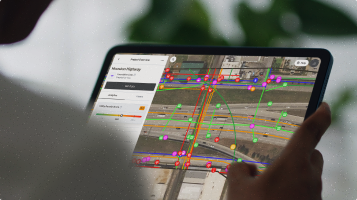What can go wrong when you don’t use utility mapping?
Written by

Published on
December 2, 2021


Table of contents
Picture this: your team is breaking ground on the job site, when suddenly: someone discovers an unexpected buried artefact by making contact with their hand tool. On further investigation, it appears to be an abandoned utility line that wasn’t documented in the plans.
Your first thought: We’re incredibly lucky no one got injured.
Your second thought: This is going to halt construction for months—until the line is fully documented, the designs revised and approved, the budget adjusted, and special contractors and tools can be arranged.
This kind of situation is exactly what utility mapping is designed to prevent.
In this post we’ll cover these main questions:
- What is utility mapping?
- Why is utility mapping an important tool?
- Why should utility mapping be used on a project?
- What can go wrong when utility mapping is not used?
What is utility mapping?
Utility mapping is a method to collect, interpret, plot, and communicate data about underground utilities (as well as aboveground utilities). Utility mapping can be used for the purposes of planning, surveying, site management, infrastructure improvement, engineering, construction, utility decommissioning.
Utility mapping draws on multiple sources to collect information: utility records, remote sensing, and topographical surveys. In some cases, it can interact with on-site industry standard methods of utility detection and mapping, such as utility locating by exposing a utility, or utility designating by using surface geophysical methods.
Utility mapping interprets data by putting together the maximum number of data sources to confirm and deduce the presence of buried infrastructure. This interpretation integrates multiple geometric indications—points, lines, and areas—to generate an underground utility map to the greatest level of confidence possible.
Utility mapping plots data on a cohesive and comprehensive digital map, so that discrete pieces of information can be usefully and systematically placed at the correct geographical points on the map. This map contains vector data and uses a consistent cartographic projection to unify all data on a shared plane of reference.
Utility mapping communicates data through an interface that is easy to read, easy to navigate, and includes metadata about utilities such as the conveyed material or energy, encasing material, function, ownership, age, and so on.
Why is utility mapping an important tool?
Utility mapping is important because it addresses gaps, inconsistencies, incompatible formats, risks of misinterpretation, and logistical obstacles in the traditional utility locating process. Furthermore, it does this for a fraction of the cost and in a fraction of the time that traditional utility locating methods may impose.
Utility mapping does not replace on-site utility locating, but ensures that on-site locating activities can be done with maximal preparation and foreknowledge of where to look, what to look for, which tools to use, and how much caution is required—whether that means using hand tools or non-conductive tools.
Utility mapping ensures that scanned as-builts and raster utility map files are correctly aligned to a site plan and can be compared correctly to remote sensing and topographic survey results, with consistent coordinates, scale, and measurements.
Utility mapping also preserves data in a georeferenced, digital format that is accessible 24 hours a day. On the other hand, on-site utility marking can only be seen by going to the site, and in some cases, only during opening hours on private property. These marks can fade over time, and they may overlap or be plotted in a confusing way. Utility mapping addresses all of these problems.
Why should utility mapping be used on a project?
Utility mapping should be used on a project because it provides as much underground utility data as possible, as comprehensive an overview as possible, as early as possible, for the lowest possible price and with the quickest possible turnaround.
Utility mapping provides the data needed to optimize the entire project timeline. Not only it cost-effective and speedy, but it can prevent extremely high costs and long delays further down the line.
What can go wrong when utility mapping is not used?
The most important risk of not using utility mapping is the risk of physical injury and material damage due to accidental strikes.
But that is only the most extreme worst-case scenario. Without utility mapping, a huge variety of things can interrupt or threaten the smooth progression of the entire project.
Things that can go wrong when utility mapping is not used:
- Late discovery of existing and planned utility conflicts
- Reliance on incorrect or incomplete as-builts past early planning phases
- Multiple design changes due to incomplete survey data
- Workflow bottlenecks when large teams have to wait for locating results
- Delays in starting to arrange interagency coordination
- Misinterpretation of locating data or markings due to abandoned or unknown utilities
- Incorrect identification of ownership or type of utility shown on maps or exposed on-site
- High costs to fully locate abandoned utilities only after they are discovered on site
- Supply-chain and hiring bottlenecks to acquire specialized equipment or commission personnel to deal with hazardous or high-risk utilities nearby
- Difficulty of obtaining access or right of way needed for utility locating
Before the digital era, these were inevitable liabilities of the planning, engineering, procurement, and construction process. Now, we have the tools to prevent these incidents from happening with as much foresight and as much comprehensive data as possible.
Without utility mapping, your project is a historical relic.
With utility mapping, your project is driving the forefront of the industry.
Where do you want to be?
Recent blog posts

Our Newsletter
Join 7k infrastructure professionals
Get monthly insights on ways to build smarter, faster and safer with Utility AI.

.avif)




